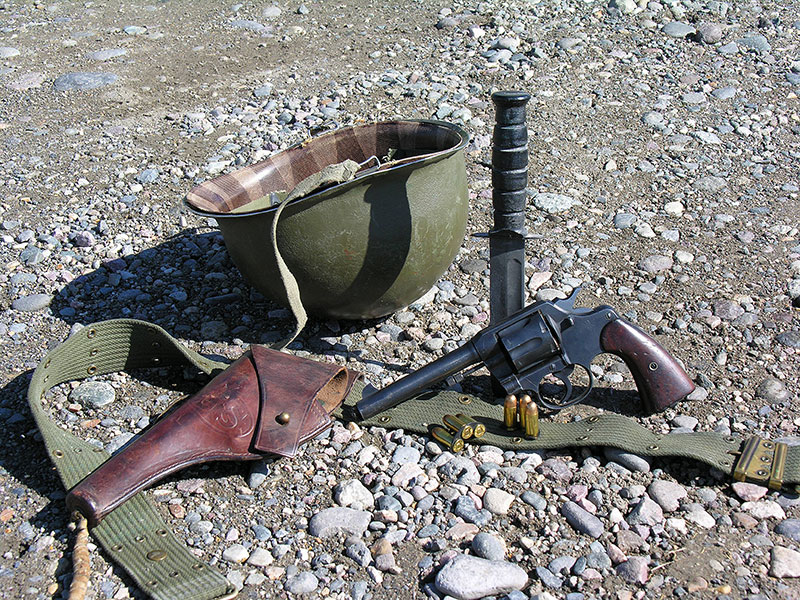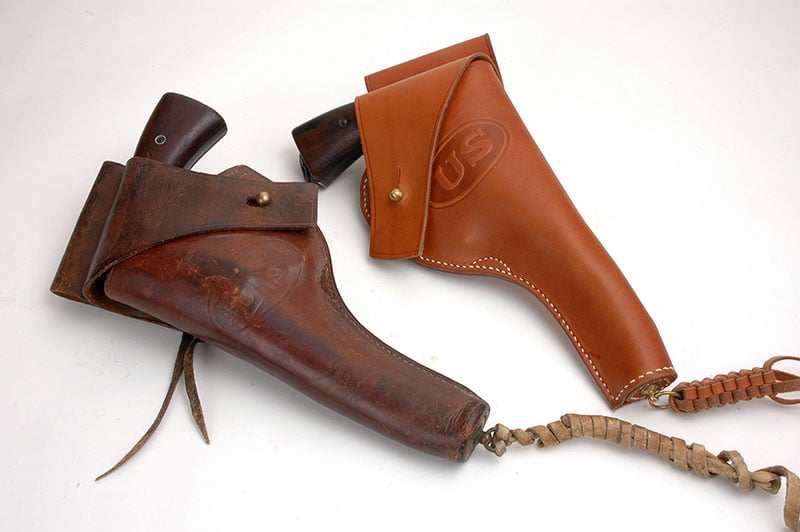Handguns Of WWII, Part 4
The U.S. Model 1917 .45 ACP (Colt Version)
Part 4 Of A 13-Part Series
Without a doubt the U.S. Army’s adoption of Model 1917 .45 ACP revolvers was a “make-do” situation. And also without a doubt it “made-do” very well. The United States had been almost as bad as the British for getting involved in a war while woefully ill-prepared. When President Wilson’s administration declared war on Germany in April, 1917, the American military had no fighting airplanes, no field artillery, no machine guns, not enough rifles and far from enough Colt Model 1911 .45 autos to go around. The government-owned Springfield Armory had been making some 1911s under license from Colt but they had to stop handgun manufacture to focus on production of Model 1903 rifles. Remington Arms Company was in the process of tooling up for 1911 production, but deliveries were in the far future.
Back in 1909, as an interim measure, the U.S. Army and U.S. Marine Corps had adopted Colt’s large frame New Service revolver chambered for .45 Colt. Everyone knew an autoloader was coming, so the military only needed enough 1909s to fill holsters until 1911s were in full production. Now hold that thought.
The first step in World War One’s handgun shortage solution came from an engineer at Smith & Wesson. Their large N-frame revolver could easily handle the rimless .45 ACP, except a star-type extractor as used on double-action revolvers needed a cartridge rim to push against for extraction. Mr. Unknown Engineer figured out the concept of little stamped steel “half-moon” clips holding three of the rimless .45 ACPs, supplying something for extractors to push against. The U.S. Government thought that was a good idea and gave Smith & Wesson the go ahead to make .45 ACP revolvers. We’ll cover their model in a future installment.
The Colt
Since the American military was already familiar with Colt’s New Service double action revolver, they also gave Colt a contract to produce .45 ACP revolvers using the half-moon clip idea. Colt’s Model 1917s were all of a type. They had a six-round cylinder capacity, used a double-action firing mechanism, came with 5 ½” barrels and were mounted with two-piece smooth walnut grips. Sights consisted of a groove down the frame’s topstrap for a rear sight and a thin blade front sight silver-soldered to a groove in the barrel.
Instead of the bright blue finish given Colt’s commercial handguns, their military version had a much rougher polish giving a dull blue finish. Then to top it off, a lanyard ring was installed in the bottom of the grip. All were stamped “U.S. Model 1917” also on the butt and “United States Property” under the barrel.
Here’s an interesting bit of trivia. To the best of my knowledge Colt and Smith & Wesson Model 1917 revolvers were the only American military weapons to get the same designation even though they were completely different handguns.
Sources vary as to exact production figures for Colt’s version of the U.S. Model 1917 .45, but it amounted to something over 150,000 in only a 14 month period. Here’s another bit of interesting trivia. Between 1899 and 1944 Colt made a few over 355,000 New Service revolvers. That means the U.S. Model 1917 accounted for about 40 percent of the total.

Duke’s three types of ammunition used to feed his Colt 1917 revolvers. At left is issue
military round with 230 grain FMJ bullet. Next is Lyman bullet #452374 (220 grains) with loaded round,
Oregon Trail Bullet Company 227 grain roundnose with loaded round and Zero Bullet Company 230 grain FMJ with loaded round.
WWII
According to Bruce Canfield’s book “U.S. INFANTRY WEAPONS OF WORLD WAR II” about 96,000 Colt 1917s survived World War I service and were then put into government storage. When World War II began, again with the U.S. military being ill-prepared, many thousands of those stored .45 revolvers were put back into service. However, before issue, they were inspected, repaired if need be, and then given a phosphate finish commonly called “Parkerizing.” That last step makes it very easy for today’s collectors to sort World War I U.S. Model 1917 .45s from World War II ones.
Most use of Colt Model 1917 .45 revolvers were not in the front lines in World War II. Mostly combat units got what U.S. Model 1911 autoloaders were available and military police, POW camp guards and assorted auxiliary troops got the revolvers. That said, front line troops are famous for begging, borrowing, or stealing any sort of handgun to pack along in combat. Therefore, many photos exist of soldiers and marines packing 1917 sixguns.
My World War II handgun collection contains two Colt U.S. Model 1917 .45s. One retains its World War I blue finish, meaning it most probably did not see service in World War II. At least it likely wasn’t officially issued. My second one does have a Parkerized finish and so likely was issued to someone. In fact it could have been issued to my own uncle, James Virse, who served as a rifleman in the 3rd Marine Division on Guam in 1944. In the 1990s he told me even after the island was declared secure, orders were that marines were to go armed at all times. That was because there were numerous Japanese stragglers roaming the jungles. The last one didn’t surrender until 1972! My uncle said he scrounged a .45 revolver and holster and carried it instead of his 10 pound M1 Garand.
And here is one last bit of trivia. Holsters for U.S. Model 1917 revolvers come in two forms. Both were flap holsters, but the World War I versions were meant to be worn on the right side but with gun butt forward. By World War II the design changed to have the revolver worn on the right side but with the gun butt to the rear.
Shooting ‘Em
My Colt U.S. Model 1917 .45s get shot. Aside from Black Hills Ammunition 230 grain FMJ factory loads, they also get handloads with 230 grain FMJs, 225 grain commercially cast roundnose, or my own home cast bullets weighing 220 grains from Lyman mould #452374. Any of those bullets go over 5.4 grains of Hodgdon’s HP38. All those combinations duplicate original military ballistics closely enough to shoot to the Colts’ sights. I am pretty darn good when shooting them in single action mode and pretty darn hopeless when trying to hit something double action.
The U.S. Government was lucky to have a handgun manufacturing giant such as Colt to help when faced with a war emergency — twice!
Click here to links to all the 13-part on-line series of Handguns Of World War 2 articles.









